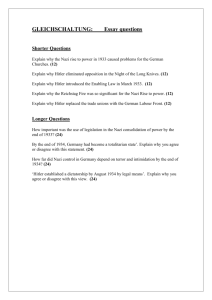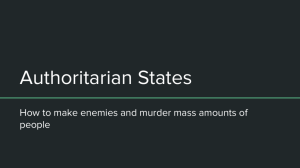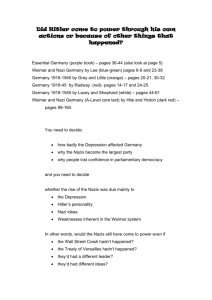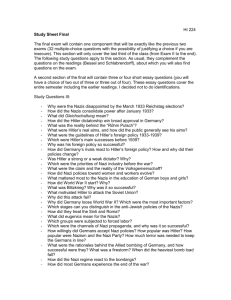WH Ch. 17 Study Guide
advertisement
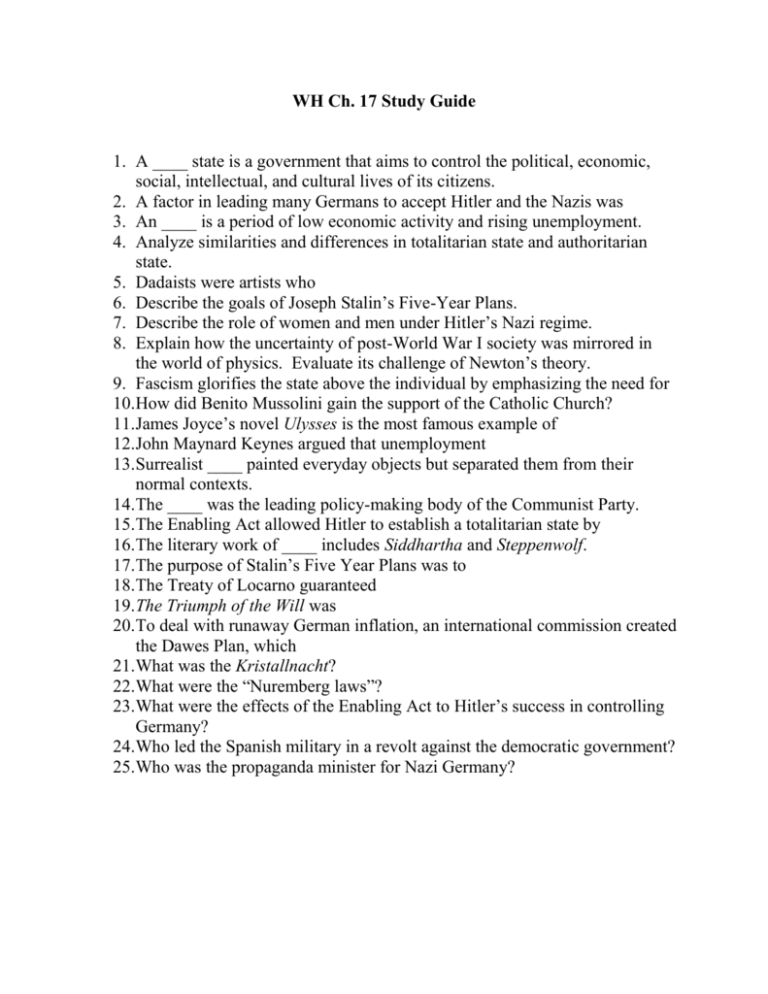
WH Ch. 17 Study Guide 1. A ____ state is a government that aims to control the political, economic, social, intellectual, and cultural lives of its citizens. 2. A factor in leading many Germans to accept Hitler and the Nazis was 3. An ____ is a period of low economic activity and rising unemployment. 4. Analyze similarities and differences in totalitarian state and authoritarian state. 5. Dadaists were artists who 6. Describe the goals of Joseph Stalin’s Five-Year Plans. 7. Describe the role of women and men under Hitler’s Nazi regime. 8. Explain how the uncertainty of post-World War I society was mirrored in the world of physics. Evaluate its challenge of Newton’s theory. 9. Fascism glorifies the state above the individual by emphasizing the need for 10.How did Benito Mussolini gain the support of the Catholic Church? 11.James Joyce’s novel Ulysses is the most famous example of 12.John Maynard Keynes argued that unemployment 13.Surrealist ____ painted everyday objects but separated them from their normal contexts. 14.The ____ was the leading policy-making body of the Communist Party. 15.The Enabling Act allowed Hitler to establish a totalitarian state by 16.The literary work of ____ includes Siddhartha and Steppenwolf. 17.The purpose of Stalin’s Five Year Plans was to 18.The Treaty of Locarno guaranteed 19.The Triumph of the Will was 20.To deal with runaway German inflation, an international commission created the Dawes Plan, which 21.What was the Kristallnacht? 22.What were the “Nuremberg laws”? 23.What were the effects of the Enabling Act to Hitler’s success in controlling Germany? 24.Who led the Spanish military in a revolt against the democratic government? 25.Who was the propaganda minister for Nazi Germany? Key 1. Totalitarian 2. The belief that Hitler had ended Germany’s economic depression and the scare of communists taking over the German government. 3. Economic depression 4. Totalitarian state is a government that aims to control the political, economic, social, intellectual, and cultural lives of its citizens. Totalitarian states wanted more than passive obedience. They wanted to conquer the minds and hearts of their subjects. They achieved this goal through mass propaganda techniques and high-speed modern communication. Modern technology also provided totalitarian states with an unprecedented ability to impose their wishes on their subjects. Authoritarian governments main concern was not to create a new kind of mass society, but to preserve the existing social order. However, authoritarian governments adopted some features of totalitarian states, including their use of police powers. 5. Tried to express in their art their revulsion for what they saw as the insanity of life 6. The Five-Year Plans set economic goals for five-year periods. Their purpose was to transform Russia virtually overnight from an agricultural into an industrial country. The first Five-Year Plan emphasized maximum production of capital goods and armaments. The plan quadrupled the production of heavy machinery and doubled oil production. Between 1928 and 1937, steel production in Russia increased from 4 million to 18 million tons per year. With rapid industrialization came an equally rapid collectivization of agriculture. Private farms were eliminated and the government took ownership of all the land. 7. Women played a crucial role in the Aryan state of Hitler’s Nazi regime. The women were the bearers of the children who, it was believed, would bring about the triumph of the Aryan race. The Nazis believed men were destined to be warriors and political leaders, while women were meant to be wives and mothers. By preserving this clear distinction, each could best serve to “maintain the whole community.” The Nazis discouraged women from taking jobs in heavy industry and certain professions, and instead encouraged women to pursue other occupations, such as social work and nursing. 8. The new picture of the universe that was unfolding in physics undermined the old certainties of the classical physics of Newton. Newtonian physics had made people believe that all phenomena could be completely defined and predicted. This belief was shaken when the German physicist Werner Heisenberg explained an observation he called the uncertainty principle. Physicists knew that atoms were made up of smaller parts. The fact that the behavior of these subatomic particles is unpredictable provides the foundation for Heisenberg’s uncertainty principle. Heisenberg’s theory essentially suggests that all physical laws are based on uncertainty. The theory’s emphasis on randomness challenges Newtonian physics and thus, in a way, represents a new world view, mirroring the uncertainty that was present in post-World War I society. 9. A strong central government led by a dictatorial ruler 10. He gave the Church money and official recognition. 11. The “stream of consciousness” technique 12. Came not from overproduction, but a decline in demand 13. Salvador Dali 14. Politburo 15. Giving the government the power to ignore the constitution for 4 years 16. Hermann Hesse 17. Transform the USSR from an agricultural into an industrial economy 18. Germany’s new western borders with France & Belgium 19. A Nazi documentary film that forcefully conveyed the power of National Socialism 20. Reduced Germany’s Reparations debt 21. It was a destructive Nazi rampage against the Jews 22. They excluded Jews from German citizenship, forbade marriages between Jews & German, required Jews to wear yellow Stars of David, and carry ID cards identifying them as Jews. 23. The right-wing elites of Germany, the industrial leaders, landed aristocrats, military officers, and higher bureaucrats, looked to Hitler for leadership. A twothirds vote of the Reichstag passed the Enabling Act. This law gave government the power to ignore the constitution for four years while it issued laws to deal with the country’s problems. This Act gave Hitler’s action legal basis. In effect, Hitler became a dictator appointed by the parliamentary body itself. With this power, Nazis purged the civil service of Jews and democratic elements. Large prison camps were set up for those who opposed the new regime. Trade unions were dissolved. All political parties expect Nazis were abolished. 24. Francisco Franco 25. Joseph Goebbels


